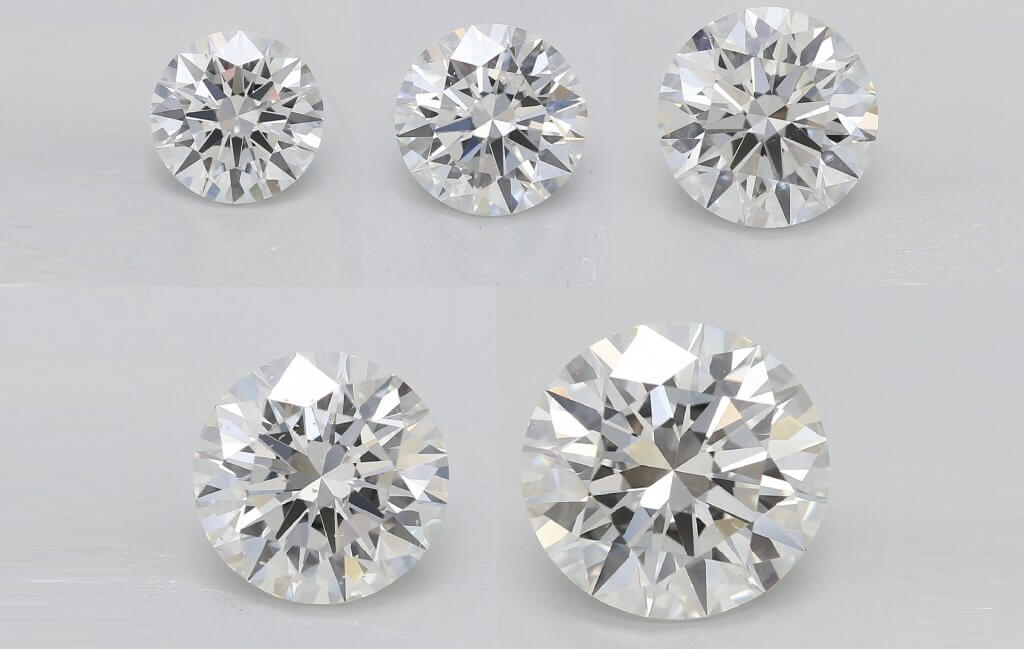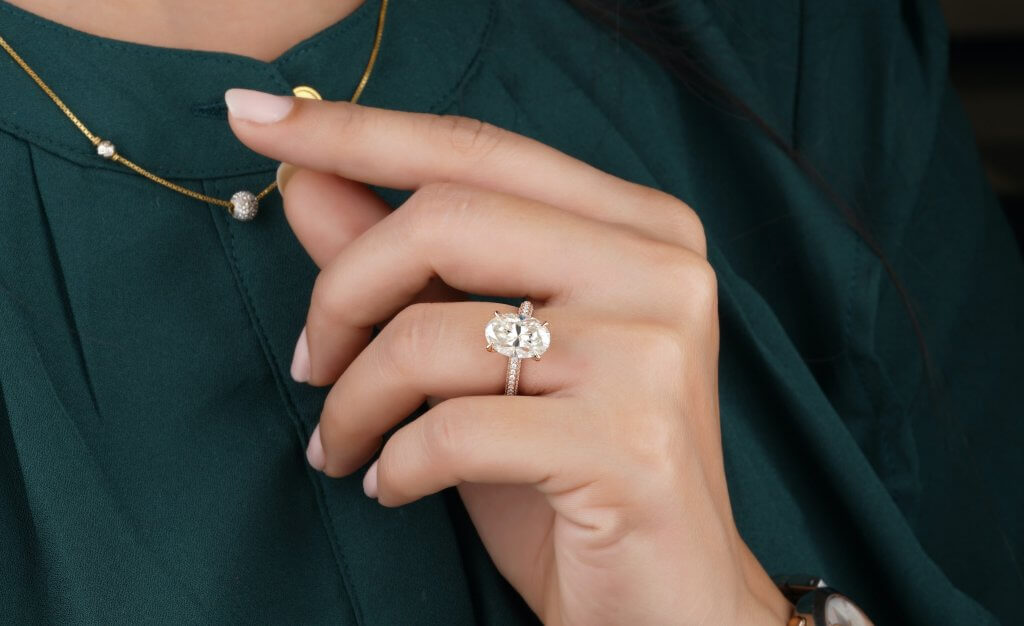Diamond Carat Size: The Ultimate Guide
Key Takeaways
- Carat weight is one of the first things any shopper will think about when they start to plan their engagement ring.
- Plenty of shoppers start off thinking that ‘carat’ correlates with size when, in fact, it’s a unit of measurement used in the world of gemology.
- For that reason, two diamonds of the same shape and carat weight can appear to be different sizes, if one is proportioned better than the other. Deep or shallow cut diamonds will appear smaller or larger (respectively) than other diamonds of the exact same weight, cut to ideal proportions.
- Carat weight is one of the most significant factors behind a diamond’s value.

When it comes to diamonds, bigger doesn’t always necessarily mean better. Even engagement rings – the ultimate landing place for any diamond – can stand out as true winners without needing to rely on a 10 carat stone to make them impressive.
But we’re getting ahead of ourselves. First of all, it pays to understand exactly what we (and your jeweler) mean by the term ‘carat’ before you start worrying over your own diamond’s carat
What is the Carat of a Diamond?
Carat is a specific weight measurement used on gemstones and pearls. It is equal to 0.2 grams, or 200 milligrams.
This unit of measurement is used around the world, meaning that, while it doesn’t tell us anything concrete about a diamond’s surface diameter, it’s pretty easy to gauge a rough idea based off carat alone (more on that below).
Carats are also assigned points
What are Diamond Carat Sizes?
While the most common tiers are 0.5, 1, 1.5, 2, and, after that, whole carat increments, a diamond’s carat weight can be any number, though it is carried out to two decimal places.
As you might have noticed by now, diamonds that weigh less than one carat can be presented as fractions or decimals of 1 carat. A 0.5 carat diamond, for instance, weights exactly 100 milligrams, while a 0.1 carat diamond will weigh 20 milligrams, or 0.02 grams – or, alternatively, 1/10th of a carat.
Since carat is shown to two decimal places, weight may be rounded up – although not in the case of magic sizes, which we will look at just below.
For now, however, we’ll leave you with this. A diamond that weighs 234.9 milligrams will be presented as 2.35 carats, while a diamond that weights 199.7 will be presented as 1.99 carats, rather than 2. You might already be able to work out why that is but, if not, here’s a brief explainer on ‘magic diamond sizes’.
Is Diamond Carat the Same as Size?
No, and this is a very important distinction for shoppers to make. Since carat refers to weight only, two diamonds of the same shape and carat weight could feature totally different weigh distributions, making them appear totally different sizes.
A 2 carat diamond that looks significantly larger than every other 2 carat diamond is not a ‘great find’ – it’s an example of how poorly a cut can be completed, and how much an otherwise beautiful diamond can suffer from it.
While it may feel restrictive, sticking to the ideal cut proportions means ensuring that your diamond is not only big, but beautiful too. It will create plenty of fire, brilliance, and scintillation, and it won’t appear squat or, conversely, stretched out and ‘skinny’.
Carat does not determine weight distribution, which means that it only tells half the story. As a shopper, you’ll want to get used to the right proportions for your chosen shape, but also to the idea that seeing a diamond in person is worth a lot more than seeing a picture online. Consulting with your jeweler means talking through the more complex aspects of your diamond, rather than weight alone.
What are Magic Sizes?
A magic size, like 0.5, -.75 or 1 carat, are considered to be more sought-after than diamonds that sit between these sizes.
If you’re hoping to use a 1 carat diamond in your engagement ring, then the odds are that you’re less likely to settle instead on a 0.99 carat diamond. It’s not unheard of, and can be a good way of saving a little money but, in general, the emphasis is placed on quarter- and half-sizes (whether that’s 0.25 carats, 1 carat, 1.5 carats), rather than the many sizes that exist in-between.
This is why the 199.7 carat diamond would not be rounded-up to 2 carats, while the 234.9 carat diamond could be presented as a 235 carat stone.
There is, of course, no noticeable difference between a 0.49 carat diamond and a 0.5 carat diamond, or a 0.99 carat diamond and a 1 carat diamond, but, for obvious reasons, they are the more popular sizes among buyers.
What do Points Mean on Diamonds?
Points are typically used for smaller diamonds below 1 carat in weight. 100 points is equal to 1 carat, meaning that 1 point is equal to a 0.01 carat diamond.
This is another useful way of conveying the weight of any given diamond, as it allows a more precise means of conveying a diamond’s weight – particularly when that diamond is very small.
Melee diamonds, or the very low carat weight diamonds typically used in halo and pavé settings, generally fall below 1/10th of a carat. In these instances, it can be easier for 0.07 carat diamonds be to refer to as 7 pointers, for instance.

What is the Difference Between Carat and Karat?
A diamond’s carat is its weight, while the proportion of gold to its alloys is measured in karats.
This is something that can easily trip-up first-time buyers of fine jewelry as, unless you’re looking exclusively at platinum for your ring, both diamond carat and gold karat are bound to crop up pretty frequently.
The most important thing to understand is that, while the two terms sound similar, they refer to totally different things.
Rather than weight or size, karat represents 1/24th of a piece of gold, meaning that 24 karat gold is totally pure. Unfortunately, pure gold is way too soft and damage-prone to be used in jewelry, so it’s alloyed with other, strengthening metals – which, in turn, drive down the purity of that piece of gold. 18 karat gold, then, is 18 ‘parts’ gold to 6 ‘parts’ alloying metals, like silver, palladium, or platinum.
Interestingly, this is why rose gold (which takes its pink-ish color from copper and silver) could never be 24k, and why it’s so much stronger than 24k gold.
So the term ‘karat’ (confusingly spelled carat outside of the US) refers to proportion, while carat is exclusively used as a unit of measurement for gemstones.

How to Tell the Carat Size of a Diamond
The easiest way to find out the carat size of any diamond is to check its GIA Report. This will have been completed by two expert diamond graders, who will have used incredibly precise scales to ascertain the exact weight of the diamonds they grade.
Furthermore, your jeweler will be able to offer you all the insight you could need into this aspect of your diamond, and more besides.
So, Which Diamond Carat is Best?
There is no ‘idea’ carat weight for any piece of jewelry – particularly engagement rings. The best thing you can do is learn about this unit of measurement, and how to make it work for you.
It’s not always easy wrapping your head around the specifics of diamond carats. For one thing, it’s pretty difficult to gauge a rough price point for any specific carat weight, given the massive discrepancies that can exist between one diamond and the next – even if they are exactly the same carat weight.
For another, the different ways individual jewelers and experts present a diamond’s carat weight can mean you have to do some mental gymnastics to get it all straight in your head. In other words, when a seventy-three pointer means the same thing as a 0.73 carat diamond – which might also be presented as 0.73 ct or ¾ of a carat – it’s not always easy to keep your head straight.
Still, it won’t take long before you start to feel more comfortable with this particular unit of measurement – and, in particular, with using it as a way of sorting through the massive numbers of diamonds on the market today to find one that is perfect for your vision for that ring.
So, in essence, look at it this way: you’re learning about carats in order to make a good decision further down the line. You’re not, however, learning about carats in order to find out what carat weight is ‘right’. That’s something you can only know when you’ve taken cut, clarity, color, cost and your future bride’s tastes into account.








